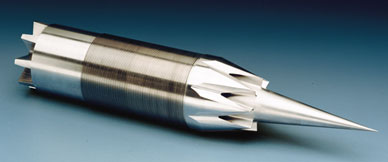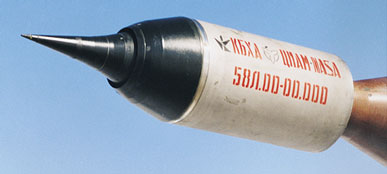A Burning Question
By David Schneider
When was the first scramjet flight-tested?
When was the first scramjet flight-tested?

DOI: 10.1511/2002.39.0
In late July, engineers at the University of Queensland in Australia wowed the aerospace community when they flight-tested an experimental supersonic-combustion ramjet (or "scramjet") engine. Unlike conventional rocket engines, which must carry oxidizer on board, ramjets and scramjets take in air from the atmosphere and compress it enough to burn. Scramjets do so while letting the air pass through them at supersonic velocities—an impressive feat not unlike keeping a candle lit in a hurricane. Although the scramjet idea is decades old, these engines have yet to show their worth in real applications. But after the technical roadblocks are overcome, scramjets could one day power hypersonic missiles with great efficiency and may even help lift vehicles into space more cheaply than the current generation of boosters.

GASL, Inc.
How long that might take is unclear. One hurdle is that scramjet engines are inherently difficult to try out because they operate only when they are taking in air at several times the speed of sound. Although these conditions can be simulated in ground tests, the methods used to accelerate air to these speeds introduce troubling uncertainties. So scramjet designers have labored to try out their creations under real operating conditions.
The Australian team adopted a novel solution to the problem. Rather than attempting to send their device horizontally through the sky for a lengthy test flight, they launched it on a parabolic trajectory into space and tested it for a few seconds on the way down, as it plunged back into the atmosphere. This maneuver allowed them to evaluate the operation of their device while it was traveling at about eight times the speed of sound, or, in the parlance of the trade, at Mach 8.
Onboard sensors confirmed that combustion occurred in one of two parallel chambers. This did not, however, reflect a partial misfire: The second chamber was purposely not provided with fuel, so that the engineers would know exactly what physical changes burning produced. According to Myles Frost, a member of the Australian team, flight data indicated that air flowed through the combustion chamber at about Mach 2.7, clearly qualifying it as supersonic combustion.
Press releases from the University of Queensland proudly announced that the Australian investigators had made the world's first successful flight test of scramjet technology. A Reuters report even noted that the team regarded confirmation of their scramjet's operation as one of the most significant technological advances since American Chuck Yeager became the first person to break the sound barrier in 1947. The Australian flight is indeed an aviation milestone, but it's not so clear that it should be regarded as the first time a scramjet engine was successfully flight-tested.
A little more than a year before, engineers from GASL, a New York company, had successfully flight-tested a scramjet-powered projectile at Arnold Air Force Base in Tennessee. The "flight" in this case took place within a long test chamber filled with air at a pressure equal to conditions at 50,000 feet. Rather than using a rocket to get the scramjet up to speed, technicians at this Air Force facility fired it from the large gun housed at the base expressly for testing high-velocity projectiles. "We certainly did get flight test data," says Anthony Castrogiovanni, president of GASL, noting that sending a scramjet through Arnold's experimental chamber is really not all that different from sending one through the atmosphere high above the Earth, "It is air and it is, in fact, free flight."
Asked whether the GASL trials last year constituted a prior successful flight test of a scramjet, Frost answers, "Technically, no," noting that "it's a simulated environment." But he adds that "the environment is pretty damn good," which in his view makes the issue a matter of semantics as to whether one should regard such an experiment as a ground test or a flight test. Perhaps the Solomon-like assessment is to consider the GASL experience, to borrow Frost's words, "a successful ground-based flight test."

NASA
But there are other reasons to question the conclusion that the recent Australian flight constitutes the first demonstration of a scramjet high in the sky. A combination ramjet-scramjet engine designed and built by engineers at Russia's Central Institute for Aviation Motors was repeatedly tested during the 1990s using a surface-to-air missile to accelerate it to operational speeds. Two trials were conducted jointly with French engineers, including François Falempin, who reports that the Russian engine achieved a speed of Mach 5.7 and that within its combustion chamber "we measured the average Mach number always above one." Further tests made jointly with NASA pushed the Russian scramjet even faster. These were carried out in the dead of the Siberian winter so that the extreme cold would make the fuel on the missile denser than normal, allowing more to be packed in and increasing the top speed to about Mach 6.5.
John Hicks, then of NASA's Dryden Research Center, spearheaded the NASA effort to help test the Russian engine. He notes that the 70 seconds or so of flight data they obtained in 1998 are open to different interpretations, depending on the computational codes used to infer the conditions at various points within the engine. According to Hicks, his Russian colleagues concluded that the engine had indeed managed supersonic combustion, whereas his coworkers at NASA's Langley Research Center were more skeptical.
One of the skeptics at Langley was Randy Voland, who explains that it is very hard to get fully supersonic combustion at Mach 6.5. He and his colleagues published a report on the experiment describing various technical malfunctions and concluding that flow in the combustion chamber was "primarily subsonic." That report helps explain why the Australian engineers concluded that they had pulled off a first. Yet Voland allows that "the core probably was supersonic" and notes simply that "we were looking for something purer."
Voland isn't, however, willing to credit the Australians with the first successful test flight of a scramjet engine. He points out that the Australians were not flying a true engine: "It was more of a fundamental combustor test than an engine test." His assertion has considerable merit, given that the Australian device exhausted its combustion products out the side and did not produce thrust by sending them rearward, which, after all, is the very definition of jet propulsion. In contrast, the Russian scramjet generated, according to Hicks, 1,500 newtons (or about 340 pounds) of thrust and thus provided some acceleration.
So when exactly did the first scramjet fly? Credit for that aviation milestone is indeed difficult to sort out. It's not nearly as clear, say, as the first nonstop flight across the Atlantic: That happened, as everyone knows, with Alcock and Brown's flight in 1919.—David Schneider
Click "American Scientist" to access home page
American Scientist Comments and Discussion
To discuss our articles or comment on them, please share them and tag American Scientist on social media platforms. Here are links to our profiles on Twitter, Facebook, and LinkedIn.
If we re-share your post, we will moderate comments/discussion following our comments policy.